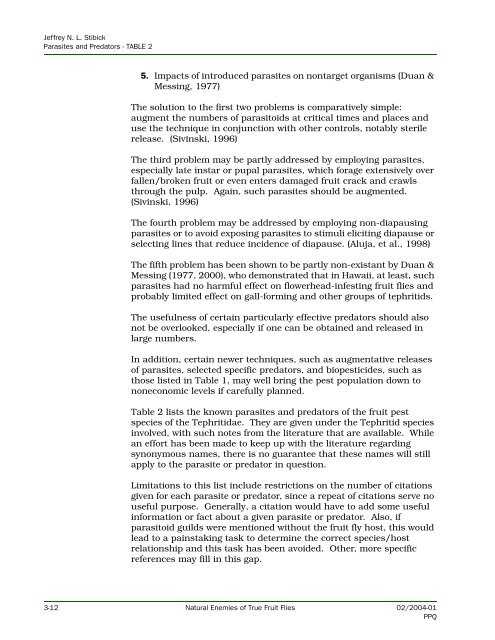Natural Enemies of True Fruit Flies (Tephritidae) - USDA - aphis
Natural Enemies of True Fruit Flies (Tephritidae) - USDA - aphis
Natural Enemies of True Fruit Flies (Tephritidae) - USDA - aphis
You also want an ePaper? Increase the reach of your titles
YUMPU automatically turns print PDFs into web optimized ePapers that Google loves.
Jeffrey N. L. Stibick<br />
Parasites and Predators - TABLE 2<br />
5. Impacts <strong>of</strong> introduced parasites on nontarget organisms (Duan &<br />
Messing, 1977)<br />
The solution to the first two problems is comparatively simple:<br />
augment the numbers <strong>of</strong> parasitoids at critical times and places and<br />
use the technique in conjunction with other controls, notably sterile<br />
release. (Sivinski, 1996)<br />
The third problem may be partly addressed by employing parasites,<br />
especially late instar or pupal parasites, which forage extensively over<br />
fallen/broken fruit or even enters damaged fruit crack and crawls<br />
through the pulp. Again, such parasites should be augmented.<br />
(Sivinski, 1996)<br />
The fourth problem may be addressed by employing non-diapausing<br />
parasites or to avoid exposing parasites to stimuli eliciting diapause or<br />
selecting lines that reduce incidence <strong>of</strong> diapause. (Aluja, et al., 1998)<br />
The fifth problem has been shown to be partly non-existant by Duan &<br />
Messing (1977, 2000), who demonstrated that in Hawaii, at least, such<br />
parasites had no harmful effect on flowerhead-infesting fruit flies and<br />
probably limited effect on gall-forming and other groups <strong>of</strong> tephritids.<br />
The usefulness <strong>of</strong> certain particularly effective predators should also<br />
not be overlooked, especially if one can be obtained and released in<br />
large numbers.<br />
In addition, certain newer techniques, such as augmentative releases<br />
<strong>of</strong> parasites, selected specific predators, and biopesticides, such as<br />
those listed in Table 1, may well bring the pest population down to<br />
noneconomic levels if carefully planned.<br />
Table 2 lists the known parasites and predators <strong>of</strong> the fruit pest<br />
species <strong>of</strong> the <strong>Tephritidae</strong>. They are given under the Tephritid species<br />
involved, with such notes from the literature that are available. While<br />
an effort has been made to keep up with the literature regarding<br />
synonymous names, there is no guarantee that these names will still<br />
apply to the parasite or predator in question.<br />
Limitations to this list include restrictions on the number <strong>of</strong> citations<br />
given for each parasite or predator, since a repeat <strong>of</strong> citations serve no<br />
useful purpose. Generally, a citation would have to add some useful<br />
information or fact about a given parasite or predator. Also, if<br />
parasitoid guilds were mentioned without the fruit fly host, this would<br />
lead to a painstaking task to determine the correct species/host<br />
relationship and this task has been avoided. Other, more specific<br />
references may fill in this gap.<br />
3-12 <strong>Natural</strong> <strong>Enemies</strong> <strong>of</strong> <strong>True</strong> <strong>Fruit</strong> <strong>Flies</strong> 02/2004-01<br />
PPQ

















